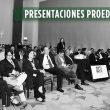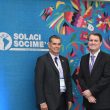We are deeply thankful to all interventional physicians who, motivated by their great scientific and educational vocation, presented their works at the “José Gabay” Course. Read the presentations below: Module I: Fundamentals and Basic Elements. Leiva Pons, José Luis. “Vascular Closure Devices. Step by Step.” (Spanish version) García García, Hector. “Current Status of Coronary Intervention:...
Relive the SOLACI-SOCIME 2018 Congress
Over 2180 professionals from all over the world gathered in Mexico City to continue developing interventional cardiology in Latin America. Relive the event through this video! We are interested in your opinion. Please, leave your comments, thoughts, questions, etc., below. They will be most welcome.
Report on Cardiovascular Death in Mexico Within the SOLACI-SOCIME 2018 Congress
How can you know if you are having an infarction? What is the rate of cardiovascular death in Mexico? What are the possible solutions to this problem? José Luis Leiva Pons, SOLACI president, and Jorge Cortés Lawrenz, SOLACI-SOCIME 2018 Congress chair, analyzed the situation of cardiovascular health in Mexico during the SOLACI-SOCIME 2018 Congress that...
Live Cases, Edited Cases and Lunch Symposiums Sponsored by the Industry
The participation of the medical industry is, undoubtedly, one of the most appealing aspects of the SOLACI-SOCIME 2018 Congress. As usual, the most important companies in this industry have decided to take part in our event. Their contribution is most valuable, as it brings relevance and improves the quality of our scientific presentations. Organize your...
Real-Life Functional Assessment of Coronary Stenosis: We Are Yet to Convert to It
The use of functional assessment of coronary stenosis (following the class IA recommendation in both American and European guidelines) is below 50% in daily clinical practice. Truth be told, most operators continue having blind faith in angiography. The inclusion of coronary physiology in the decision-making process has spread widely across countries, sites, and operators. The ERIS...
Angina Is as Subjective as Any Other Pain
Almost 80% of all patients randomized in this study reported Canadian Cardiovascular Society class II or III angina, and almost all of them (97%) had more than 1 positive non-invasive ischemia test that matched the area of their single diseased coronary vessel. Beyond fractional flow reserve (FFR) or instantaneous wave-free ratio (iFR), the study randomized patients to...
EuroPCR 2018 | FAME 2: FFR Shows 5-Year Benefit for Hard Endpoints
After a 5-year follow-up, and for the first time, functional assessment with fractional flow reserve (FFR) showed clear benefit for a hard endpoint: acute myocardial infarction. Use of FFR in patients with stable coronary artery disease so as to identify hemodynamically significant lesions in order to restrict angioplasty treatment to them has long-term benefits compared...
EuroPCR 2018 | ORBITA: The Link Between Ischemia and Symptoms Is Still Not Entirely Understood
Invasive physiology tests used in the ORBITA trial could not predict which patients would benefit from angioplasty more than placebo (sham procedure) in terms of the trial’s primary endpoint, improvement in exercise time. These data were presented at EuroPCR 2018 and published simultaneously in Circulation. Results encourage debate over the importance of ischemia reduction with angioplasty...









